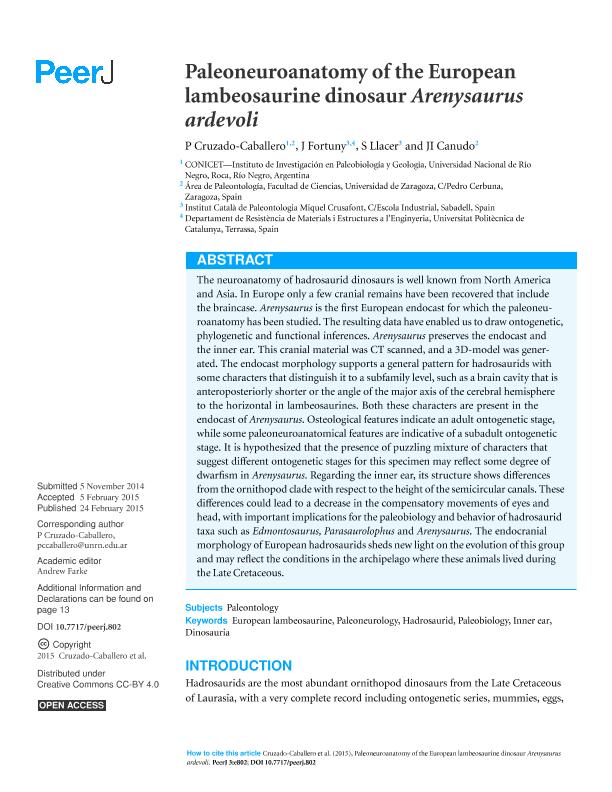Mostrar el registro sencillo del ítem
dc.contributor.author
Cruzado Caballero, Penélope

dc.contributor.author
Fortuny, J.
dc.contributor.author
Llácer, S.
dc.contributor.author
Canudo, J. I.
dc.date.available
2015-11-24T16:03:24Z
dc.date.issued
2015-02-24
dc.identifier.citation
Cruzado Caballero, Penélope; Fortuny, J.; Llácer, S.; Canudo, J. I.; Paleoneuroanatomy of the European lambeosaurine dinosaur Arenysaurus ardevoli; PeerJ, Inc; PeerJ; 3; 802; 24-2-2015; 1-16
dc.identifier.issn
2167-8359
dc.identifier.uri
http://hdl.handle.net/11336/2898
dc.description.abstract
The neuroanatomy of hadrosaurid dinosaurs is well known from North America
and Asia. In Europe only a few cranial remains have been recovered that include
the braincase. Arenysaurus is the first European endocast for which the paleoneuroanatomy has been studied. The resulting data have enabled us to draw ontogenetic, phylogenetic and functional inferences. Arenysaurus preserves the endocast and the inner ear. This cranial material was CT scanned, and a 3D-model was generated. The endocast morphology supports a general pattern for hadrosaurids with some characters that distinguish it to a subfamily level, such as a brain cavity that is anteroposteriorly shorter or the angle of the major axis of the cerebral hemisphere to the horizontal in lambeosaurines. Both these characters are present in the endocast of Arenysaurus. Osteological features indicate an adult ontogenetic stage, while some paleoneuroanatomical features are indicative of a subadult ontogenetic stage. It is hypothesized that the presence of puzzling mixture of characters that suggest different ontogenetic stages for this specimen may reflect some degree of dwarfism in Arenysaurus. Regarding the inner ear, its structure shows differences fromthe ornithopod clade with respect to the height of the semicircular canals. These differences could lead to a decrease in the compensatory movements of eyes and head, with important implications for the paleobiology and behavior of hadrosaurid taxa such as Edmontosaurus, Parasaurolophus and Arenysaurus. The endocranial morphology of European hadrosaurids sheds new light on the evolution of this group and may reflect the conditions in the archipelago where these animals lived during the Late Cretaceous.
dc.format
application/pdf
dc.language.iso
eng
dc.publisher
PeerJ, Inc
dc.rights
info:eu-repo/semantics/openAccess
dc.rights.uri
https://creativecommons.org/licenses/by-nc-sa/2.5/ar/
dc.subject
Paleoneurology
dc.subject
Paleobiology
dc.subject
Inner Ear
dc.subject
European Lambeosaurine
dc.subject
Dinosauria
dc.subject.classification
Paleontología

dc.subject.classification
Ciencias de la Tierra y relacionadas con el Medio Ambiente

dc.subject.classification
CIENCIAS NATURALES Y EXACTAS

dc.title
Paleoneuroanatomy of the European lambeosaurine dinosaur Arenysaurus ardevoli
dc.type
info:eu-repo/semantics/article
dc.type
info:ar-repo/semantics/artículo
dc.type
info:eu-repo/semantics/publishedVersion
dc.date.updated
2016-03-30 10:35:44.97925-03
dc.journal.volume
3
dc.journal.number
802
dc.journal.pagination
1-16
dc.journal.pais
Estados Unidos

dc.description.fil
Fil: Cruzado Caballero, Penélope.
dc.description.fil
Fil: Fortuny, J.. Universidad Nacional de Rio Negro. Sede Alto Valle. Instituto de Investigaciones En Paleobiologia y Geologia; Argentina
dc.description.fil
Fil: Llácer, S.. Institut Catala de Paleontologia Miquel Crusafont; España. Universidad Politecnica de Catalunya; España
dc.description.fil
Fil: Canudo, J. I.. Institut Catala de Paleontologia Miquel Crusafont; España
dc.journal.title
PeerJ
dc.relation.alternativeid
info:eu-repo/semantics/altIdentifier/url/https://peerj.com/articles/802/
dc.relation.alternativeid
info:eu-repo/semantics/altIdentifier/doi/https://dx.doi.org/10.7717/peerj.802
Archivos asociados
